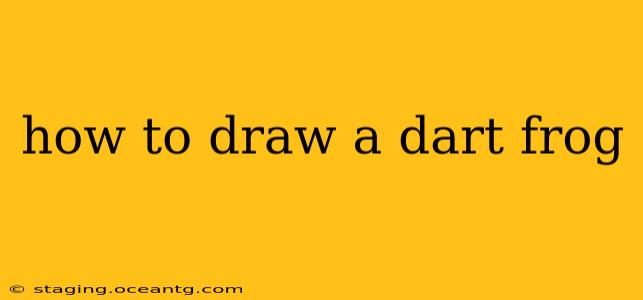Dart frogs, with their vibrant colors and captivating personalities, are a popular subject for artists of all skill levels. This guide will walk you through drawing a dart frog, from simple shapes to adding intricate details. Whether you're a beginner or looking to refine your skills, you'll find this tutorial helpful.
What Supplies Will I Need?
Before we begin, gather your art supplies. You'll need:
- Paper: Choose a paper that's suitable for your chosen medium (pencil, pen, colored pencils, etc.). Drawing paper or sketchbook paper works well.
- Pencil: A standard HB or 2B pencil is ideal for sketching. A softer pencil (like a 4B or 6B) can be used for darker shading.
- Eraser: A kneaded eraser is best for lifting pencil marks without damaging the paper.
- Sharpener: Keep your pencil sharp for precise lines.
- Optional: Colored pencils, markers, paints, or other mediums for adding color.
Step-by-Step Drawing Guide
1. Basic Shapes: The Foundation
Begin by sketching the basic shapes that will form the body of your dart frog. Think of a slightly elongated circle for the body and a smaller circle for the head. Connect these circles with a gently curved line.
2. Defining the Head and Body
Refine the shapes of the head and body. Make the head slightly more rounded and add a small, slightly pointed snout. Give the body a more three-dimensional feel by slightly curving the sides.
3. Adding Legs and Feet
Sketch four long, slender legs, each ending in four tiny toes. Don't worry about perfect symmetry; dart frogs often have slightly uneven leg positioning.
4. Eyes and Other Features
Draw two large, round eyes, slightly bulging and positioned on the sides of the head. Add nostrils as small dots just below the eyes. Consider adding a subtle smile or a slightly open mouth.
5. Adding Details: Skin Texture and Patterns
This is where you can really bring your dart frog to life! Dart frogs have unique skin textures and patterns. Some have smooth skin, while others have bumpy or warty textures. Many species have striking patterns, like stripes, spots, or blotches. Use your pencil to subtly suggest these details, using hatching or cross-hatching techniques for texture.
6. Refining the Lines and Adding Shadows
Once you're happy with the details, carefully refine the lines of your drawing. Erase any unnecessary guidelines. Add shading to give the frog dimension. Consider where the light source is and add shadows accordingly. Pay particular attention to the areas around the legs, under the belly, and in the creases of the skin.
Frequently Asked Questions
How do I draw realistic-looking skin texture on a dart frog?
Creating realistic skin texture involves understanding how light interacts with the surface. Use hatching, cross-hatching, or stippling techniques to create a sense of depth and variation in the skin's surface. Observe images of real dart frogs to identify the specific texture of the species you are drawing.
What colors are best for drawing dart frogs?
Dart frogs come in an incredible range of colors, from bright greens and blues to yellows, oranges, and reds. Often they have a combination of these. Choose colors that match the specific species you're depicting.
What are some common mistakes to avoid when drawing a dart frog?
Common mistakes include drawing the legs too short or thick, failing to create convincing skin texture, and neglecting to add sufficient shading to give the frog a three-dimensional appearance. Careful observation of reference images is key to avoiding these errors.
Are there any online resources or tutorials that can help me?
Yes! Searching for "how to draw dart frogs" on YouTube will provide numerous video tutorials with different approaches and styles. Websites like Pinterest and DeviantArt also offer a wealth of dart frog drawings to study and learn from.
By following these steps and practicing regularly, you'll be able to draw stunningly realistic and expressive dart frogs. Remember to have fun and experiment with different styles and techniques. Your artistic journey is just beginning!
